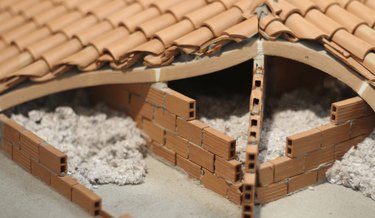Things You'll Need
Stepladder
Tape measure

Older homes usually do not have enough insulation in the attics. By adding insulation there, you can seriously cut your energy bills because it adds a thermal barrier that provides resistance against heat flow. Because a machine blows the insulation into the cavities between joists in the attic, it's hard to know just how much you need. A simple formula can give you the amount of R-value coverage; you can then compare this figure against the U.S. Department of Energy's chart recommendations for your climate zone.
Step 1
Find a place that represents the average blown-in insulation coverage inside the attic. If you choose a high spot, you will not get an accurate idea of the attic's R-value. R-value represents the insulation's resistance to heat transfer. Many homes require at least R-38 in the attic, but homes situated in colder regions may require a lot more.
Video of the Day
Step 2
Insert a tape measure next to a joist at the location found in Step 1. Measure the distance from the base of the joist to the spot where the insulation stops.
Step 3
Examine the insulation for the type you have, as each type has a different R-value. White, pink or yellow cotton-looking balls consist of insulation made of fiberglass. Fiberglass insulation has an R-value of 2.5 per inch of depth. For dense off-white or gray insulation with black speckles, the attic contains mineral wool. It has a 2.8 R-value per inch of depth. Cellulose, made from recycled newspapers treated with a fire retardant, looks like shredded gray paper; it has an insulating R-value of 3.7 per inch of depth.
Step 4
Complete the calculation to arrive at the total R-value in your attic for the amount already blown in. For instance, if you have fiberglass insulation in your attic 12 inches deep, the insulation has an R-value of 30. To arrive at R-38, you need at least 15.2 inches of blown-in fiberglass insulation, requiring you to add 3.2 more inches of insulation if you already have 12. For rock mineral wool, you need approximately 13.57 inches, and with cellulose, you require just 10.27 to achieve R-38.
Step 5
Calculate the depth of insulation needed in advance if you haven't added any insulation to your attic yet. Take the R-value number for the recommended insulation in your climate zone and divide that by the R-value per inch figure for the type of insulation you plan to use. This provides you with the coverage depth needed to successfully insulate your attic. Calculate the square footage of the attic to determine the amount of insulation needed at the recommended depth. Insulation manufacturers often package blown-in insulation in bags with a specific cubic foot amount of coverage. To estimate the number of bags you'll need, convert the desired insulation depth to feet (for example, 4 inches is 0.33 feet), then multiply by the square footage of the attic space to find the cubic feet of insulation required. Divide the result by the cubic feet of coverage stated on the insulation package to determine the number of bags needed.
Tip
Check the insulation recommendations for your area before you rent the machine to blow in the insulation or hire a contractor to do it for you. That way, you know you can calculate the amount of insulation needed beforehand.
Use caulk and other materials to air-seal the ceiling between the attic and living space below. While insulation provides resistance for heat transfer, it does nothing to block air leaks, and airflow through insulation greatly diminishes its performance.
Warning
Have your attic inspected by a qualified professional if you can't identify any existing insulation. Vermiculite is a pebble-like loose-fill insulation that's typically either gray-brown or silver-gold in color. Vermiculite insulation may contain asbestos and should not be disturbed.
If you plan a do-it-yourself installation, make certain to wear goggles and a face mask or an approved respirator to avoid breathing in the small fibers. If you plan to add fiberglass insulation, wear a long-sleeve shirt as well.
Video of the Day
- U.S. Department of Energy Oak Ridge Laboratory: Adding Insulation to an Existing House
- U.S. Department of Energy Oak Ridge Laboratory: Insulation Recommendations for New Wood-Framed Houses
- U.S. Department of Energy Oak Ridge Laboratory: What Kind of Insulation is Best?
- U.S. Department of Energy Oak Ridge Laboratory: Insulating a New House (Doing It Right the First Time)
- U.S. Department of Energy Oak Ridge Laboratory: ZIP Code Insulation Program